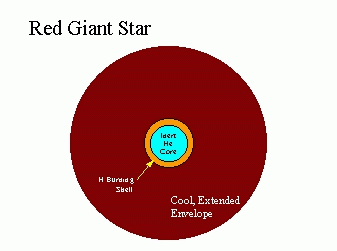The layer immediately above the core becomes hot enough to initiate the fusion of hydrogen into helium.
The star now has THREE main layers:
A giant's outer hydrogen envelope cools as it expands. A giant becomes very large in radius and very cool -- hence the name RED GIANT, commonly applied to giant stars.

In a red giant a huge, cool, low-density hydrogen envelope (with a density of about 0.1 kilograms/m3) encloses a small, hot, high-density helium core (with a density of about 1,000 tons/m3).
Once the central temperature reaches T > 100,000,000 Kelvin, helium can fuse into carbon - a new energy source. Why must the temperature be so high? Because the electric charge of a helium nucleus is twice that of a hydrogen nucleus, it takes higher velocities (and hence higher temperatures) to overcome the electrostatic repulsion and bring helium nuclei together.
Only stars with M > 0.4 Msun become hot enough for
fusion of helium to occur. Lower mass stars, once they eventually
leave the main sequence, are fated to end up as spheres of helium.
Helium is fused into carbon by the triple alpha
process. Just as a hydrogen nucleus has the alias ``proton'', a
helium nucleus has an alias as well -- nuclear physicists refer
to helium nuclei as ``alpha particles''. Thus, the fusion
process which combines three helium nuclei, or alpha particles,
into one carbon nucleus is called the triple alpha process.
Step one of the triple alpha process:
4He + 4He --> 8Be
Step two:
8Be + 4He --> 12C + gamma ray photon
Sometimes there is an additional reaction:
12C + 4He --> 16O + gamma ray photon
Thus, the triple alpha process mainly produces carbon (C), but sometimes it ``overshoots'' and produces oxygen (0). The beryllium (Be) that is produced in step one is merely an intermediate.
All the carbon and oxygen in your body was manufactured inside a star.
Only stars with M > 4 Msun become hot enough for fusion of carbon & oxygen to occur. Stars with 0.4 Msun < M < 4 Msun are fated to end up as spheres of carbon & oxygen. (This will be the fate of the Sun, for instance, which will never become hot enough to fuse into more massive elements.)
IRON is the end of the line where fusion is concerned. The iron nucleus (containing 26 protons) is the most tightly bound of all nuclei. The fusion of iron nuclei ABSORBS energy, instead of EMITTING energy.
Although each fusion process taking you from hydrogen to iron emits energy, each step, as the nuclei become more massive, is less efficient. For instance, fusing 1 kilogram of hydrogen into helium yields 650 trillion joules. Fusing 1 kilogram of helium into carbon by the triple alpha process yields only 60 trillion joules, less than 10 percent as much. Thus, as the star's core becomes hotter, and the fusion reactions powering it become less efficient, each new fusion fuel is used up in a shorter time.
For instance, consider the stages in the life of a 25 Msun star:
A star's lifetime as a giant or supergiant is shorter than its main sequence lifetime (about 1/10 as long). Thus, giants are supergiants are rare compared to main sequence stars of the same mass.
Eventually, every star runs out of fuel for fusion. The energy content of the star drops as it continues to radiate photons into space. Pressure drops in the core. Eventually, one of two things must happen:
(1) The star finds an alternative pressure source to maintain
hydrostatic equilibrium. (This means a pressure
source which doesn't rely on the random thermal
motions of atoms and ions.)
OR
(2) The star collapses into a black hole.
Updated: 2003 Jan 29
Copyright © 2003, Barbara Ryden